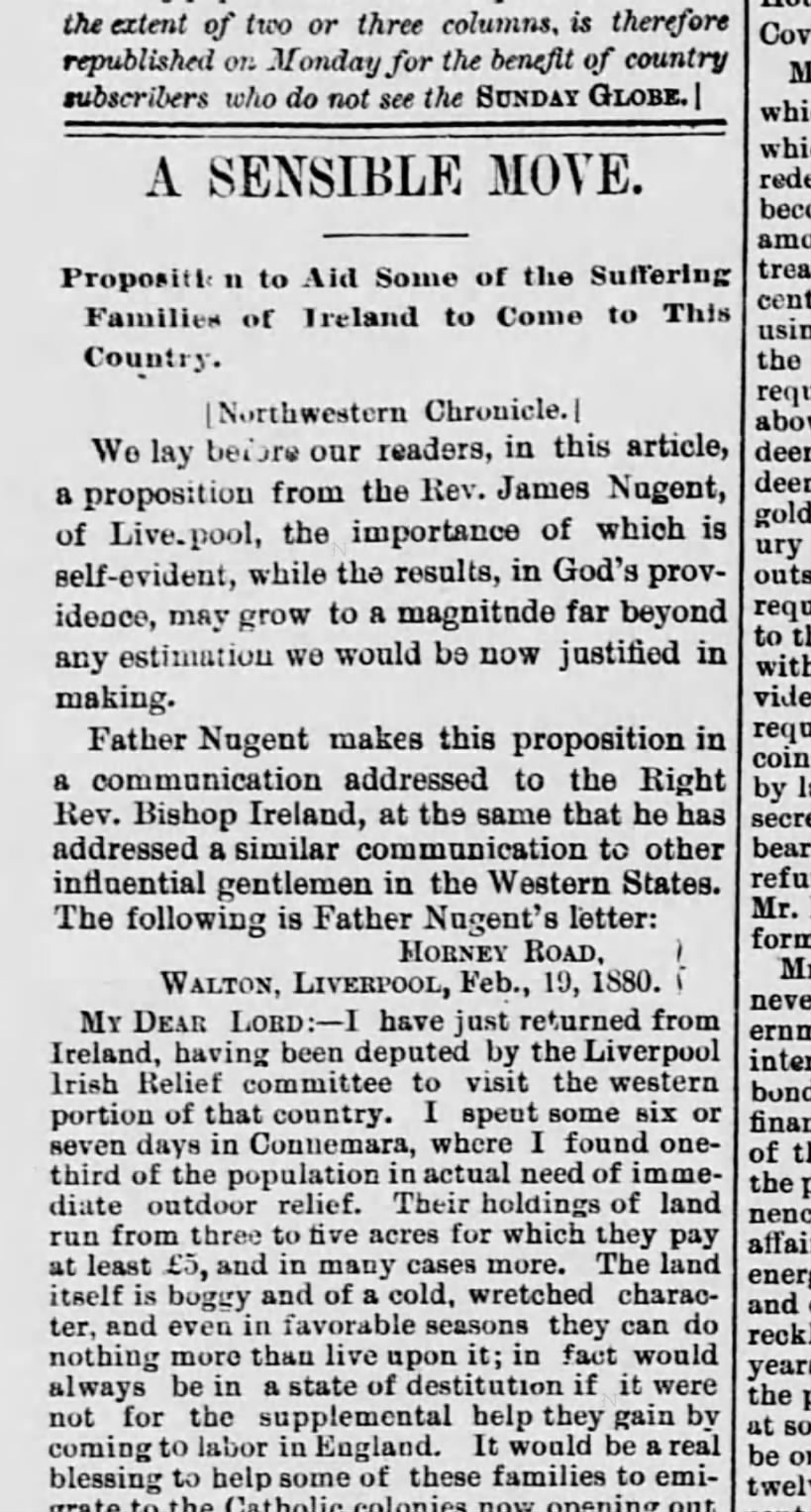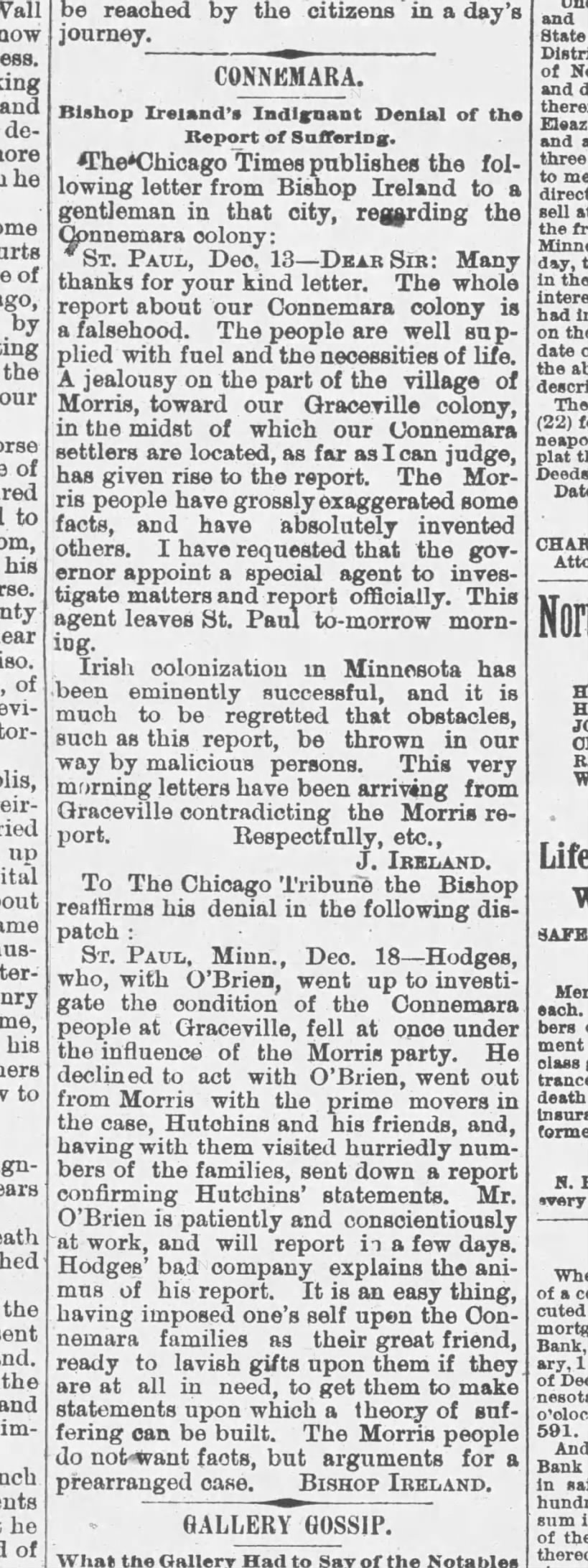Connemara Patch
In Saint Paul, Minnesota, Swede Hollow was know as the Swedish slum and the nearby Connemara Patch was home to the Irish. Unlike the Swedes, the Irish journey to Minnesota included a big detour out of the way.
No Good Choices
In 1880, Minnesota had more land than it knew what to do with and the Catholic church wanted to fill that land with parishioners. At the same time, people were starving because of famine in Connemara, Ireland.
American Catholic Bishop John Ireland (yes, really - his last name was Ireland) saw a mutually beneficial opportunity and raised funds to help 300 “Connemaras” immigrate to America. Each family was offered 160 acres of land, a small house, and enough food for a year - on loan. Their new village on the far western edge of Minnesota called Graceville was ready for their arrival in June of 1880. Or so they thought.
From Bad to Worse
Things fell apart quickly. First, when the group reached Saint Paul the teens and young adults were separated from the families. They were told to stay in the city and find jobs so they could send money to their families in Graceville.
Second, no one had made sure that the Connemaras either knew how to farm or wanted to farm. In fact, most of them were fishermen and had no idea where to start. Arriving in the summer, they had missed the spring planting time. There was no way they were going to get crops in the ground that first year because they still needed to break the sod, so they were expected to work for the railroads or other local farmers in the meantime to support themselves. On top of all of that, record breaking blizzards made for an absolutely brutal winter. Soon, the “Connemaras” were again starving and now they were freezing, too.
Finger pointing
The Irish immigrants settled in Graceville shivered, scraped and struggled through the winter of 1880-1. Several people died and more than a few lost limbs to frostbite. They were questioned by officials trying to get to the bottom of who was at fault for this whole debacle. There homes were inspected. Every scrap of food was listed, every action judged, every penny counted.
Everyone started pointing fingers: Bishop Ireland was irresponsible, the Connemaras were greedy, lazy liars, the locals in nearby Morris were jealous. Bishop Ireland’s defensive letters were published internationally - putting all of the blame on the Connemaras to such an extent that the word Connamara became an insult. At the same time, others stood up for the Irish and defended them, saying they were in an impossible situation. No one was going to believe the word of the poor immigrants over that of a powerful Catholic Bishop.
Giving Up
In the end, as soon as spring came and the roads cleared most of the Connemaras were brought to Saint Paul to reunite with the younger members and find jobs. They set up camp at the southern end of Swede Hollow and it was given the nickname “Connemara Patch”.
After most of the Connemaras left for Saint Paul, some still weren’t ready to give up. They finally got the shingles on their roofs and planted their fields working towards the day they could buy their land from the Catholic Church.
Except it never belonged to the Catholic Church.
The farmers paid Bishop Ireland, who was supposed to pay the railroads, who were supposed to have gotten the land from Congress. But Congress decided that the railroads had improperly claimed the land and took some of it back. Suddenly, farmers who had fought against all of the troubles and worked the land for years were at risk of losing it all.
After years of lawsuits, a few were granted Homesteader Rights and they were able to buy their land directly from the government. Dozens of other farms - about 28,000 acres - were bought by Bishop Ireland and the farmers were required to buy the land from him for $6 per acre - which was 50% more than they were originally promised. The farmers and locals were outraged, many of them expressing the belief that Bishop Ireland had defrauded the good people.
But those voices were drowned out. Bishop Ireland had much more success settling other groups of immigrants on over 369,000 acres of Minnesota land through the Catholic Colonization Society. Colonies in Avoca, Fulda, Clontarf, Degraff, Mineota, and Ghent were populated with Irish Catholic immigrants.
For the Catholic Church, the program was a stunning success and John Ireland became the first Archbishop of Saint Paul.
They Remember
In Minnesota this history was almost forgotten. In some cases it was intentional. The Connemara Irish were labeled so harshly that families often chose to hide their heritage or any connection to the group that had failed so spectacularly at Graceville. Descendents of the original Connnemaras were raised not knowing how or why their families ended up in Minnesota.
One such descendent, Bridget Connelly, grew up in Granville and thought her family was entirely unconnected to the Connemaras. That is, until a voice from Ireland reached out and opened the door to her family’s true history. She details her journey to uncover many family stories she had never known before in her book, Forgetting Ireland.
In August 2022, a memorial was dedicated in Carna, Connemara, Ireland to commemorate those who lived in the Connemara Patch in Saint Paul.




























